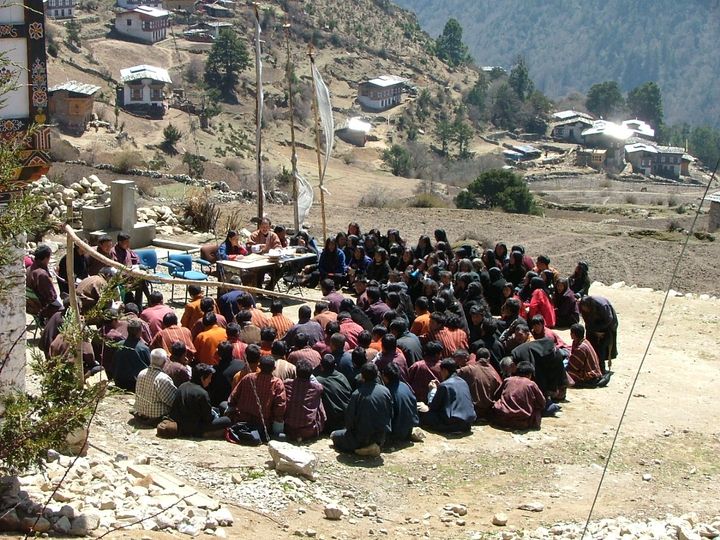
Gross National Happiness is important in Bhutan. Villagers of Laya gather to discuss their annual development plans (Photo: Chencho Gyalmo Dorjee, UNCDF)
Since the beginning of the 21st century we have witnessed a more than ten-fold increase in the number of deaths from violent extremism and terrorism. Over the past five months alone we have witnessed terrorist attacks in cities as diverse as Barcelona, Manchester, London, Benghazi, Ouagadougou, Stockholm, Baghdad, Charlottesville, Kabul, Damascus, Mogadishu, Tehran, Herat, and many others. Why are urban areas becoming increasingly prime targets of terrorist activities?
First, multi-dimensional poverty has increasingly become urban and slums are now the visible face of horizontal inequalities and marginalisation. One in seven people today live in deteriorated, overcrowded spaces in urban areas often completely segregated, spatially, economically, politically and socially. Those with little prospects for a better future may pose as potential recruitment pools for violent extremists.
Second, cities, and megacities in particular no longer feature the traditional social control mechanisms that still exist in the smaller rural communities. The anonymity of the larger cities provides a safe haven for organised crime, gangs and violent extremists, making attacks harder to detect and more difficult to prevent.
Third, the gathering within a relatively small geographical area of people, infrastructure, interests and symbols of power make cities the perfect target to inflict maximum physical and psychological damage, while easily gaining global media coverage.
But while statistics show significant levels of violence in cities, both the international and the national response to this challenge has been slow.
At the international level, the Sustaining Peace resolutions of the UN Security Council and General Assembly do not explicitly address the urban dimensions of violence and conflict, or the impact of rapid urbanization on peace and security.
At the national level, the response has also been slow in moving from a nation-wide, security-focused approach to a more locally driven prevention-focused and developmental approach. The debate has been dominated by national agencies in charge of intelligence, law enforcement and border control. An important prevention role needs to be played by our cities, municipalities and local communities.
The 2030 Sustainable Development Agenda includes a Goal (16) on building peaceful and inclusive societies and a Goal (11) on making cities and human settlements inclusive, safe, resilient and sustainable. The New Urban Agenda (NUA) adopted in 2016 proposes culturally-sensitive measures for urban safety, crime and violence prevention, including terrorism and violent extremism, and proposes to engage local communities and non-governmental actors. It explicitly calls for avoiding the stigmatization of specific groups.
UNDP’s recent research on the root causes of violent extremism is instructive, also from an urban perspective. A UNDP study on radicalization in Sudan revealed that 60% of the people joining extremist groups are from the capital Khartoum, the majority being university students. Only 3% of them join for economic reasons, as opposed to 30% of fighters that were recruited in Darfur and other rural areas. Majority of the recruits in urban and rural areas had higher education degrees. But the research reveals that the further away students are from their families and the social control of their communities, the more vulnerable they are to highly skilled recruiters.
Research needs to become more localized, so that we can better understand why certain communities are more vulnerable, or more resilient than others. One way to achieve that is by gaining a better understanding of the characteristics of the social structures, formal and informal governance and communication systems, social cohesion initiatives etc. of a resilient and cohesive community.
Conclusions are still preliminary, but from our experience working around the globe on democratic governance, conflict and violent extremism prevention, I would call attention to the following ten chromosomes of a resilient, tolerant and cohesive community:
1.There are effective formal and informal early-warning- system to respond in a timely manner to emerging risks of conflict and radicalization that can lead to violent extremism.
2.There is visible participation by minority, marginalized, and “ghettoized” communities and groups in decision-making processes on community matters, whether these are of a political, economic, social or cultural nature.
3.The narratives of the political, civic and religious leaderships and the media are oriented towards tolerance, inclusion and dialogue, and there are visible signs of engagement and integration.
4.There are spaces and platforms for debate and dialogue, and those spaces provide voice for the angry and disenchanted.
5.Efforts are made to orient the justice and security system towards confidence-building with marginalized groups, so that security sector institutions are not seen as punitive institutions only. These efforts include dialogue between the people and the community police and deliberate policies to recruit police men and women from within the community.
6.There is opportunity and ability on the part of youth, women, faith-based leaderships, and trusted intermediaries such as teachers and social workers to engage alienated or radicalized groups and individuals, in a climate of trust.
7.There is constant attention to improve service delivery and creating jobs and economic opportunities, particularly for the remote areas and groups at risk.
8.There are accessible and affordable formal and informal mechanisms to address grievances.
9.There is a local culture of integrity and a rejection of all forms of corruption. 10.Finally, the family is an important instrument of prevention and women in particular play an important role, in their homes, families and communities.
A peaceful, just and inclusive world is possible, but it needs to be built on the foundations of tolerance and respect for diversity and human rights. Where else can that be better realised, than in our cities, municipalities and communities?
